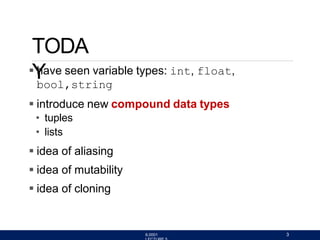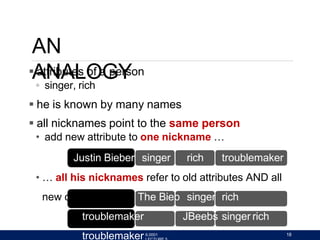The document discusses key concepts in Python programming, specifically focusing on data types such as tuples and lists. It explains the properties of these types, including their mutability, aliasing, and cloning, along with methods for manipulating them. Additionally, it provides examples on how to iterate, add, and remove elements in lists, as well as the potential side effects of mutating lists.



![TUPLES
an ordered sequence of elements, can mix element
types
cannot change element values, immutable
represented with parentheses
te = ()
t = (2,"mit",3)
t[0]
(2,"mit",3) + (5,6)
evaluates to 2
evaluates to
(2,"mit",3,5,6)
t[1:2]
t[1:3]
len(t)
slice tuple, evaluates to
("mit",)
slice tuple, evaluates to
("mit",3)
evaluates to 3
t[1] = 4 gives error, can’t modify
object 6.0001 4](https://image.slidesharecdn.com/tuples-240124095449-86ec3558/85/White-paper-on-tuples-4-320.jpg)

![MANIPULATING
TUPLES
can iterate over
tuples
def get_data(aTuple):
nums = ()
words = ()
for t in aTuple:
nums = nums + (t[0],)
if t[1] not in words:
words = words + (t[1],)
min_n = min(nums)
max_n = max(nums)
unique_words = len(words)
return (min_n, max_n, unique_words)
aTuple:(( ),( ),( ))
nums( )
words( ? ? ? )
if not already in words
i.e. unique strings from aTuple
6.0001 6](https://image.slidesharecdn.com/tuples-240124095449-86ec3558/85/White-paper-on-tuples-6-320.jpg)
![LIS
TS
6.0001 7
ordered sequence of information, accessible by
index
a list is denoted by square brackets, []
a list contains elements
• usually homogeneous (ie, all integers)
• can contain mixed types (not common)
list elements can be changed so a list is mutable](https://image.slidesharecdn.com/tuples-240124095449-86ec3558/85/White-paper-on-tuples-7-320.jpg)
![INDICES AND
ORDERING
a_list = []
L = [2, 'a', 4, [1,2]]
len(L) evaluates to
4
L[0] evaluates to
2
L[2]+1 evaluates to
5
L[3]
L[4]
i = 2
L[i-1]
evaluates to [1,2], another list!
gives an error
evaluates to ‘a’ since L[1]='a'
above 6.0001 8](https://image.slidesharecdn.com/tuples-240124095449-86ec3558/85/White-paper-on-tuples-8-320.jpg)
![CHANGING ELEMENTS
lists are mutable!
assigning to an element at an index changes the
value
L = [2, 1, 3]
L[1] = 5
L is now [2, 5, 3], note this is the same
object L
L
[2,5,3]
6.0001 9](https://image.slidesharecdn.com/tuples-240124095449-86ec3558/85/White-paper-on-tuples-9-320.jpg)
![ITERATING OVER A LIST
compute the sum of elements of a list
common pattern, iterate over list
elements
total = 0
for i in range(len(L)):
total += L[i]
print total
notice
• list elements are indexed
0
to len(L)-1
• range(n) goes from 0 to n-
1
total = 0
for i in L:
total += i
print total
6.0001 10](https://image.slidesharecdn.com/tuples-240124095449-86ec3558/85/White-paper-on-tuples-10-320.jpg)
![OPERATIONS ON LISTS
- ADD
add elements to end of list with
L.append(element)
mutates the list!
L = [2,1,3]
L.append(5) L is now [2,1,3,5]
what is the dot?
• lists are Python objects, everything in Python is an
object
• objects have data
• objects have methods and functions
• access this information by
6.0001 11](https://image.slidesharecdn.com/tuples-240124095449-86ec3558/85/White-paper-on-tuples-11-320.jpg)
![OPERATIONS ON LISTS -
ADD
6.0001 12
to combine lists together use concatenation, +
operator, to give you a new list
mutate list with L.extend(some_list)
L1 = [2,1,3]
L2 = [4,5,6]
L3 = L1 + L2 L3 is [2,1,3,4,5,6]
L1, L2 unchanged
L1.extend([0,6]) mutated L1 to
[2,1,3,0,6]](https://image.slidesharecdn.com/tuples-240124095449-86ec3558/85/White-paper-on-tuples-12-320.jpg)
![OPERATIONS ON LISTS -
REMOVE
delete element at a specific index with
del(L[index])
remove element at end of list with L.pop(), returns
the removed element
remove a specific element with
L.remove(element)
• looks for the element and removes it
• if element occurs multiple times, removes first
occurrence
• if element not in list, gives an error
L = [2,1,3,6,3,7,0] # do below in order
L.remove(2) mutates L = [1,3,6,3,7,0]
L.remove(3) mutates L = [1,6,3,7,0]
del(L[1])
L.pop()
mutates L = [1,3,7,0]
returns 0 and mutates L =
[1,3,7]
6.0001 13](https://image.slidesharecdn.com/tuples-240124095449-86ec3558/85/White-paper-on-tuples-13-320.jpg)
![CONVERT LISTS TO
STRINGS AND BACK
6.0001 14
convert string to list with list(s), returns a list with
every character from s an element in L
can use s.split(), to split a string on a character
parameter, splits on spaces if called without a parameter
use ''.join(L) to turn a list of characters into a
string, can give a character in quotes to add char between
every element
s = "I<3 cs"
list(s)
s.split('<')
L = ['a','b','c']
''.join(L)
'_'.join(L)
s is a string
returns ['I','<','3','
','c','s']
returns ['I', '3 cs']
L is a list
returns "abc"
returns "a_b_c"](https://image.slidesharecdn.com/tuples-240124095449-86ec3558/85/White-paper-on-tuples-14-320.jpg)
![OTHER LIST
OPERATIONS
6.0001 15
sort() and sorted()
reverse()
and many more!
https://docs.python.org/3/tutorial/datastructures.ht
ml
L=[9,6,0,3]
sorted(L)
L.sort()
L.reverse()
returns sorted list, does not
mutate L
mutates L=[0,3,6,9]
mutates L=[9,6,3,0]](https://image.slidesharecdn.com/tuples-240124095449-86ec3558/85/White-paper-on-tuples-15-320.jpg)




![CLONING A
LIST
create a new list and copy every element
using
chill = cool[:]
6.0001 20](https://image.slidesharecdn.com/tuples-240124095449-86ec3558/85/White-paper-on-tuples-20-320.jpg)


![MUTATION AND
ITERATION
Try this in Python Tutor!
avoid mutating a list as you are iterating
over it
def remove_dups(L1, L2):
for e in L1:
if e in L2:
L1.remove(e)
L1 = [1, 2, 3, 4]
L2 = [1, 2, 5, 6]
remove_dups(L1, L2)
L1 is [2,3,4] not [3,4] Why?
• Python uses an internal counter to keep track of index it is in the
loop
• mutating changes the list length but Python doesn’t update the
counter
def remove_dups(L1, L2):
L1_copy = L1[:]
for e in L1_copy:
if e in L2:
L1.remove(e)
6.0001 23](https://image.slidesharecdn.com/tuples-240124095449-86ec3558/85/White-paper-on-tuples-23-320.jpg)
